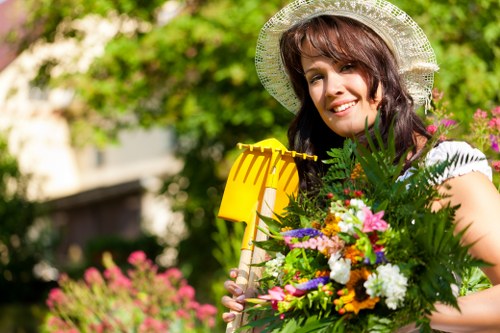Mastering Hedge Trimming: Essential Tips for the Aspiring Gardener

Hedge trimming is a fundamental aspect of garden maintenance that not only enhances the aesthetic appeal of your outdoor space but also promotes the health and vitality of your hedges. Regular trimming helps maintain the desired shape and size, ensuring that your hedges complement the overall landscape design.
Proper hedge trimming can prevent overgrowth, reduce the risk of disease, and encourage new growth. It is an essential practice for gardeners who wish to maintain a neat and organized garden environment.
In addition to the visual benefits, trimming hedges can create privacy, acting as a natural barrier against wind and noise. This makes your garden a more comfortable and tranquil space for relaxation and outdoor activities.

Having the right tools is crucial for effective hedge trimming. The primary tools you will need include hedge shears, electric or gas-powered hedge trimmers, pruning saws, and protective gear. Each tool serves a specific purpose and can help you achieve precise cuts with ease.
Hedge shears are ideal for smaller hedges and detailed trimming, allowing for greater control and accuracy. Electric or gas-powered hedge trimmers are suitable for larger hedges, offering efficiency and speed for extensive trimming jobs.
Pruning saws are essential for thicker branches that cannot be easily cut with shears or trimmers. Additionally, wearing protective gear such as gloves, safety glasses, and sturdy footwear ensures your safety while trimming.

Trimming hedges involves a systematic approach to ensure that the plants remain healthy and visually appealing. Start by assessing the current shape and size of your hedges to determine the extent of trimming required.
Begin by removing any dead, diseased, or damaged branches. This helps prevent the spread of disease and encourages healthy growth. Next, establish the desired shape by cutting back the outer branches, ensuring symmetry and balance.
For a more formal look, aim for straight lines and sharp angles, while for a natural appearance, opt for a more organic shape. Regular maintenance trimming throughout the growing season keeps your hedges in optimal condition.

Maintaining healthy hedges requires adherence to best practices in trimming and care. Avoid cutting too much of the hedge at once, as this can stress the plant and hinder its growth. Instead, trim gradually over time to maintain the desired shape.
Ensure that your tools are sharp and clean to make precise cuts and reduce the risk of introducing diseases. Disinfecting your tools between trims can prevent the spread of pathogens.
Watering and fertilizing your hedges appropriately supports their health and growth. Proper sunlight exposure is also essential, so consider the placement of your hedges to ensure they receive adequate light.

Even experienced gardeners can make mistakes when trimming hedges. One common error is trimming hedges too late in the season, which can damage the plants and inhibit new growth. It's best to prune hedges during their active growing season for optimal results.
Another mistake is over-trimming, which can lead to weak growth and an unkempt appearance. Always trim with moderation, focusing on maintaining the natural shape of the hedge.
Neglecting to maintain your trimming tools can also result in uneven cuts and potential damage to your hedges. Regular maintenance of your tools ensures that they perform effectively and contribute to the health of your plants.

Different seasons require different approaches to hedge trimming. In spring, focus on shaping new growth and removing any winter damage. Summer trimming should aim to maintain the shape and manage the growth during the peak season.
In autumn, pruning helps prepare hedges for the winter months by removing excess growth that could be damaged by frost. Avoid heavy trimming in winter, as this can expose hedges to harsh weather conditions.
Understanding the seasonal needs of your hedges ensures that they remain healthy and resilient throughout the year. Tailoring your trimming practices to the seasons enhances the longevity and beauty of your plants.

Choosing the appropriate hedge species is crucial for achieving the desired look and functionality in your garden. Consider factors such as climate, soil type, growth rate, and maintenance requirements when selecting hedges.
Popular hedge choices include boxwood for formal designs, yew for dense privacy screens, and privet for fast growth. Each species has unique characteristics that can influence your garden's overall aesthetic.
Consulting with a local nursery or gardening expert can provide valuable insights into the best hedge options for your specific environment and gardening goals.

Adopting eco-friendly practices in hedge trimming contributes to sustainable gardening and environmental preservation. Use manual tools where possible to reduce energy consumption and carbon footprint.
Recycling hedge clippings by composting them enriches your garden soil, promoting healthy plant growth without the need for chemical fertilizers. Avoiding harmful pesticides and opting for natural pest control methods ensures that your hedges remain free from toxins.
Incorporating native plant species into your hedges supports local ecosystems and biodiversity, providing habitat for beneficial insects and wildlife. Sustainable trimming practices help maintain the balance and health of your garden environment.

For gardeners seeking to refine their hedge trimming skills, advanced techniques can enhance the precision and artistry of your trimming efforts. Techniques such as coppicing, layering, and topiary allow for creative and intricate hedge designs.
Coppicing involves cutting back hedges to ground level to stimulate new growth, resulting in a fuller and denser hedge over time. Layering can create multi-dimensional shapes, adding depth and interest to your garden.
Topiary is an art form that shapes hedges into geometric or whimsical forms, showcasing the gardener's creativity and skill. Mastering these techniques requires practice and patience but can result in stunning and unique garden features.

Proper maintenance of your hedge trimming tools ensures their longevity and effectiveness. Regular cleaning removes debris and prevents rust, while sharpening blades maintains cutting precision.
Store your tools in a dry, secure place to protect them from the elements and potential theft. Inspect your equipment before each use to identify any issues that may need addressing.
Investing in high-quality tools and maintaining them diligently reduces the need for frequent replacements and supports efficient hedge trimming practices.

While DIY hedge trimming can be rewarding, there are instances where hiring a professional gardener is advantageous. Large or complex hedge trimming tasks may require specialized skills and equipment that professionals possess.
Professional gardeners can provide expert advice on hedge selection, trimming techniques, and overall garden maintenance, ensuring optimal results. They also save you time and effort, allowing you to focus on other aspects of your garden.
Hiring a professional is particularly beneficial during major trimming projects, seasonal maintenance, or when dealing with challenging hedge species that require specialized care.

Understanding the cost factors involved in hedge trimming services helps you make informed decisions and budget accordingly. Costs can vary based on the size and density of your hedges, the complexity of the trimming required, and the frequency of maintenance.
Additional factors such as the type of tools used, the expertise of the gardener, and the geographical location can also influence pricing. Obtaining multiple quotes ensures that you receive competitive rates and value for the services provided.
Investing in regular professional hedge trimming can result in long-term savings by maintaining the health and appearance of your hedges, preventing costly repairs or replacements in the future.

Deciding between DIY and professional hedge trimming depends on several factors, including your skill level, time availability, and the specific needs of your hedges. DIY trimming offers cost savings and personal satisfaction but requires the right tools and knowledge to achieve good results.
On the other hand, professional trimming ensures high-quality and consistent results, backed by expertise and experience. Professionals can efficiently handle large or difficult trimming tasks that might be challenging for homeowners.
Weighing the pros and cons of each option helps you determine the best approach for maintaining your hedges effectively and within your budget.

How often should I trim my hedges? Generally, hedges should be trimmed at least twice a year—once in early spring and once in late summer. However, some fast-growing species may require more frequent trimming.
What is the best time of day to trim hedges? The best time to trim hedges is during a cool, overcast part of the day, typically in the morning or late afternoon. This helps prevent excessive moisture loss and stress to the plants.
Can I plant new hedges in a garden with existing ones? Yes, but ensure that there is adequate spacing and consider the growth rate and eventual size of each hedge species to prevent overcrowding and competition for resources.

Hedges can play a versatile role in garden design, serving as borders, privacy screens, or focal points. When planning your garden layout, consider how hedge placement can enhance the overall aesthetics and functionality of the space.
Using hedges to create distinct garden zones can add structure and organization. Incorporating a variety of hedge species with different textures and heights can add visual interest and depth to your garden design.
Thoughtfully designed hedges contribute to a harmonious and balanced garden environment, making your outdoor space more inviting and enjoyable.

Mastering hedge trimming is a rewarding endeavor that enhances the beauty and health of your garden. By understanding the importance of regular trimming, using the right tools, and adhering to best practices, you can maintain elegant and thriving hedges year-round.
Whether you choose to undertake hedge trimming yourself or hire a professional gardener, the key is consistency and attention to detail. Investing time and effort into proper hedge care pays off with a stunning and well-maintained garden space.
Ready to transform your garden with perfectly trimmed hedges? Contact us today to book your hedge trimming service and experience the difference a professional touch can make.



